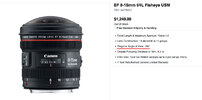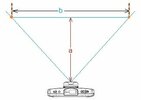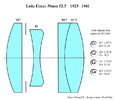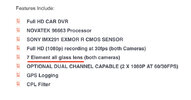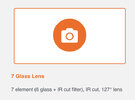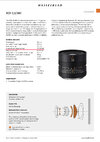Dashmellow
Well-Known Member
- Joined
- Sep 22, 2013
- Messages
- 18,300
- Reaction score
- 18,935
- Location
- Uncanny Valley (●_●)
- Country
- United States
- Dash Cam
- Umpteen
FOV vs AOV
For some reason, the term FOV (Field of View) has become the default term everyone uses to describe how wide or narrow a view is provided by the lenses that come installed on our dash cams, even though this is technically incorrect terminology for describing this. We all do it, even me at times. The correct term is AOV (Angle of View). AOV is an optical lens specification that characterizes each and every lens whereas FOV is not as it is a relative term.
We can mostly thank dash camera manufacturers and retailers for this, along with other misinformation that is regularly spread by the industry for marketing and sales promotional purposes. (more on this at a later date). Somehow FOV has become embedded in everyone's brain as the default term because it kind of sounds about right and partly thanks to widespread use on the internet it is the term everyone uses even though it is inaccurate.
Typically, you'll see the term FOV used incorrectly in marketing, like this promotion for a video doorbell camera.

So, this thread is an attempt to clarify the definitions of AOV & FOV in the service of educating our membership in the hope that it moves the knowledge needle forward a little.
Field of View (FOV) is the extent of the observable world that is seen by a lens at any given moment.
Angle of View is the decisive variable for the visual perception of the world seen by a given lens.
In other words, every lens of a given focal length will have only one angle of view but the same lens can have many fields of view according to what it is pointed at.
Angle of View (AOV) has to do with the focal length of the lens and is a measurement in degrees of how wide the frame will be from the front of the camera lens. This is why a “wide angle lens” covers a wide area with “angle being the operative word. AOV will always be fixed with each primary lens and never changes. It is strictly a function of the focal length of the lens expressed in degrees to describe the coverage the lens can observe.
You will never see a standard wide angle lens described as a “wide field of view lens”, hence this post.
Field of View (FOV) is variable. In photography, the field of view is that part of the world that is visible through the camera at a particular position and orientation in space. This means it is simply a measurement of how much a lens can frame depending on how far away the camera is from the subject and this is why using the term FOV to describe the overall frame coverage of a lens in degrees is wrong, especially with dash cams as the FOV is constantly changing as we drive and because of this we see many fields of view as we travel around in our vehicles. As such, the FOV when you are right behind another car in bumper to bumper traffic will be different than the FOV when you are driving on an open highway with the horizon way out in front of you.
FOV is often referred to as the "solid angle of scene opposite the camera lens".
If you park your car facing a brick wall only 20 feet away with a typical dash camera, the frame captured by your camera is your FOV (solid angle of scene opposite the camera lens).
If you park the same car with the same dash camera facing a football field or an ocean, the frame captured by your camera will also be your FOV (solid angle of scene opposite the camera lens).
So again, Angle of View is an optical lens specification and it is fixed and finite and is entirely a function of the focal length of a specific lens which is what determines the overall angle of coverage in degrees that can be captured any given lens.
Field of View is variable and is determined entirely by the distance to the subject within the angle of view. So unlike AOV it is not a specification describing a specific brand, coverage and design of lens, it is merely a situational measurement describing what that lens can see at that moment at that particular distance.
AOV - Angle of View - measured in degrees.
FOV - Field of View - measured in linear units and also often expressed in degrees.
Field of View is a term commonly and correctly used with binoculars. You might see a binocular’s FOV (or AFOV angular field of view or LFOV linear field of view) specifications described as - something like, Linear Field of View “330 feet/1000 yards - AFOV - 6.3 degrees” (AFOV refers to what can be seen at a given distance). This means that looking through binoculars at a scene 1000 yards away you will see a FOV 330 feet wide (horizontal). Looking through the same pair of binoculars at a subject at a closer distance of 500 yards you would see a much smaller area at greater magnification and therefore a smaller AFOV. Unlike the dash cam industry, binocular manufacturers have this terminology correct, in part because the nature of how binoculars are used requires it. Field of view will decrease with higher magnification in the same way you see less through a telescope or telephoto lens (which have a very narrow AOV - Angle of View) but the FOV increases and widens when you're looking at something much farther away.
Field of View can be measured horizontally, vertically and diagonally. This usually refers to how images are captured but sometimes refers to how images are displayed.
You will sometimes see the following acronyms used.
HFOV: Horizontal Field of View
VFOV: Vertical Field of View
DFOV: Display or Diagonal Field of View
AFOV: Angular Field of View
AOV and FOV are closely related and indeed joined at the hip within the same lens. In fact, there is a direct and vital relationship between AOV and FOV, as one does not exist without the other, thus, you can convert one to another using basic high school trigonometry.
The formula that is most commonly cited for calculating lens angle of view is:
Angle of view (in degrees) = 2 ArcTan( sensor width / (2 X focal length)) * (180/π)
You would calculate FOV using the equation:Field of view = 2 (Tan (Angle of view/2) X Distance to Subject)
These simple formulas are basic high school level trigonometry.AOV can be measured horizontally, vertically, or diagonally, although for most photographic purposes it is usually measured diagonally.

If you don't want to read the entire explanation above, this graphic will tell you all you really need to know about the difference between AOV and FOV.
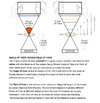
Last edited:






